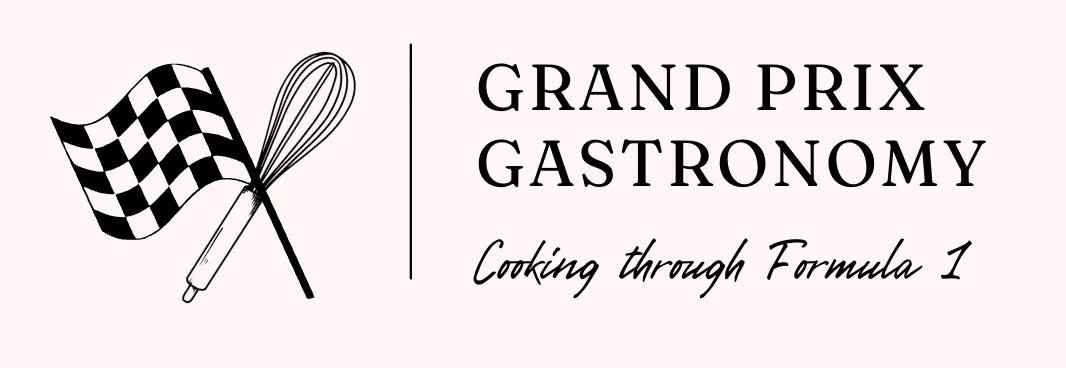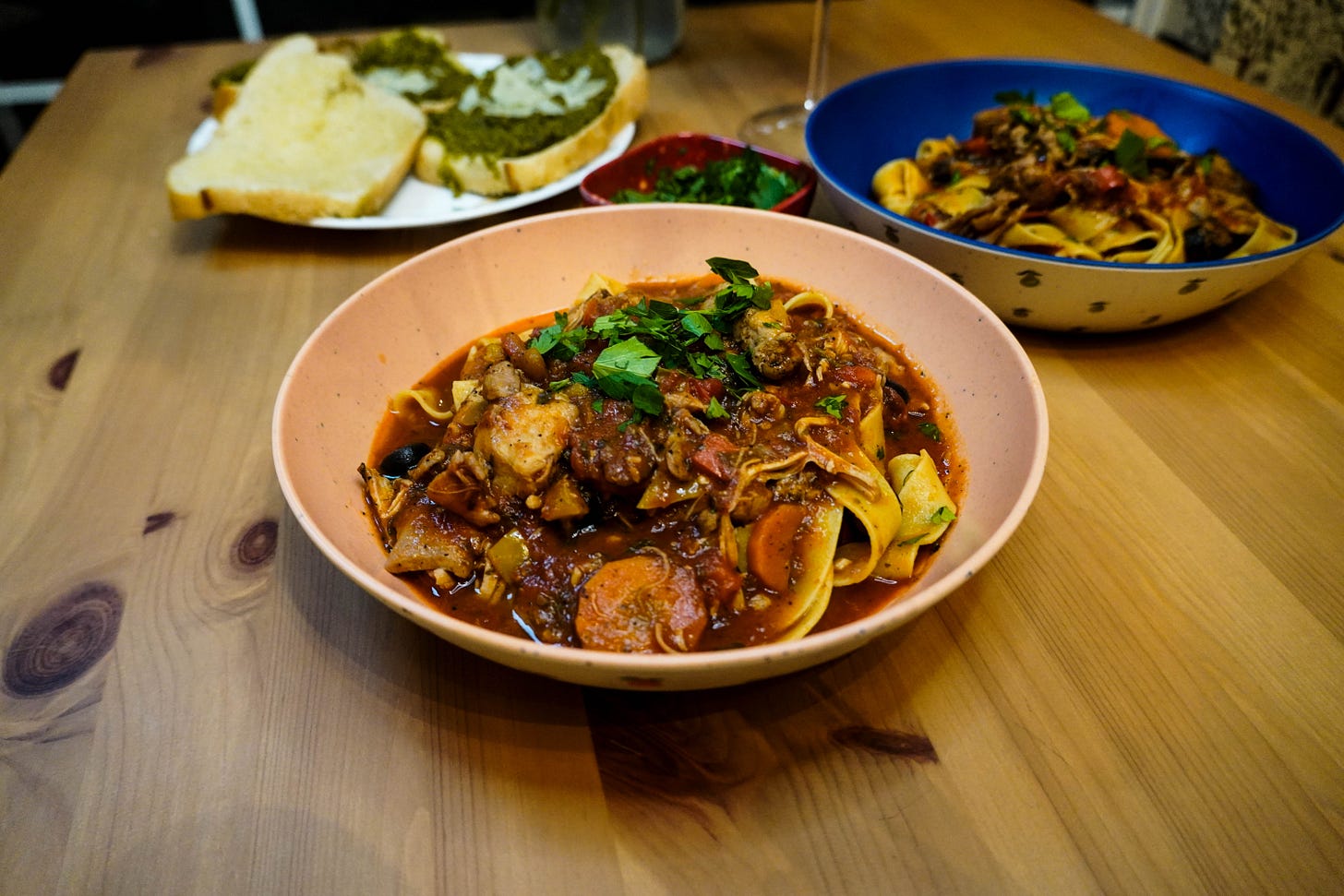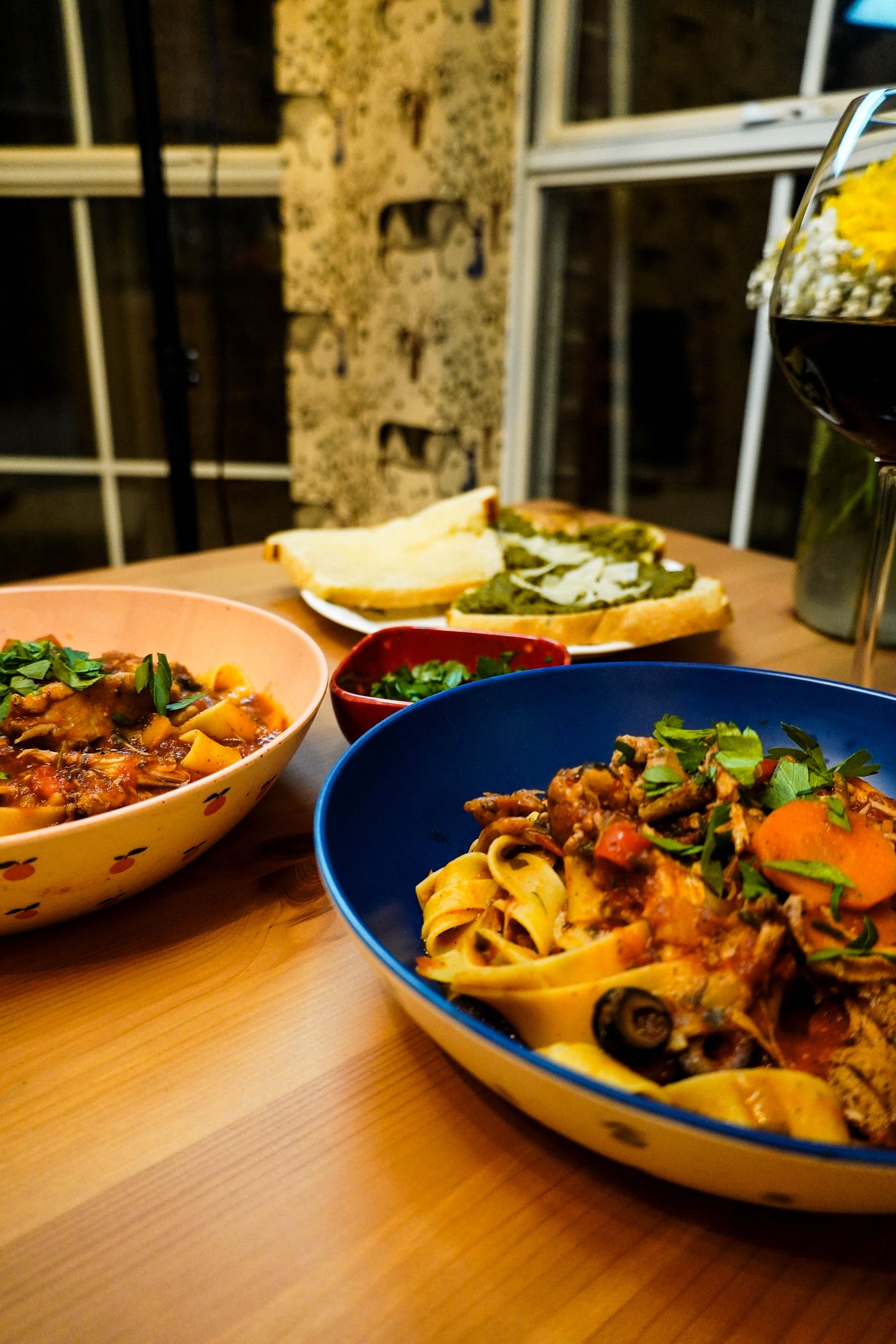Oscar Piastri's Pasta, Chicken & Tomato Sauce (Or: Chicken Cacciatore)
We're transforming Oscar's pre-race meal into a decadent feast
Welcome to Grand Prix Gastronomy! In 2024, this series is dedicated to cooking the favorite dishes of every driver on the grid.
The Foods That Oscar Piastri Loves
Oscar, baby, you're not giving me much to work with. When asked for his favorite food for his “My First Day” blackboard in 2023, this man wrote “pasta.” When asked what he likes to eat in a TikTok, he said that before races he eats pasta with tomato sauce and chicken. I can only imagine that's the blandest, most athlete-focused pasta with tomato sauce and chicken anyone could ever eat. I cannot do that to myself.
Instead, I've decided to go ahead and throw together Elizabeth Blackstock's version of pasta with chicken and tomato sauce. We're going to do something fun. We’re going to get crazy. And because I'm really taking creative liberties with this (admittedly vague) dish concept, I'm keeping Mr. Piastri locked in for the Australian Grand Prix.
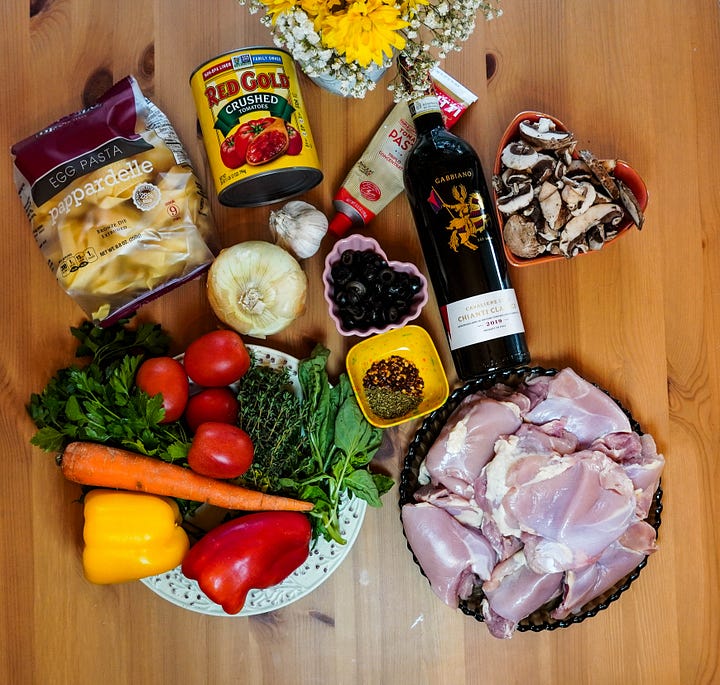
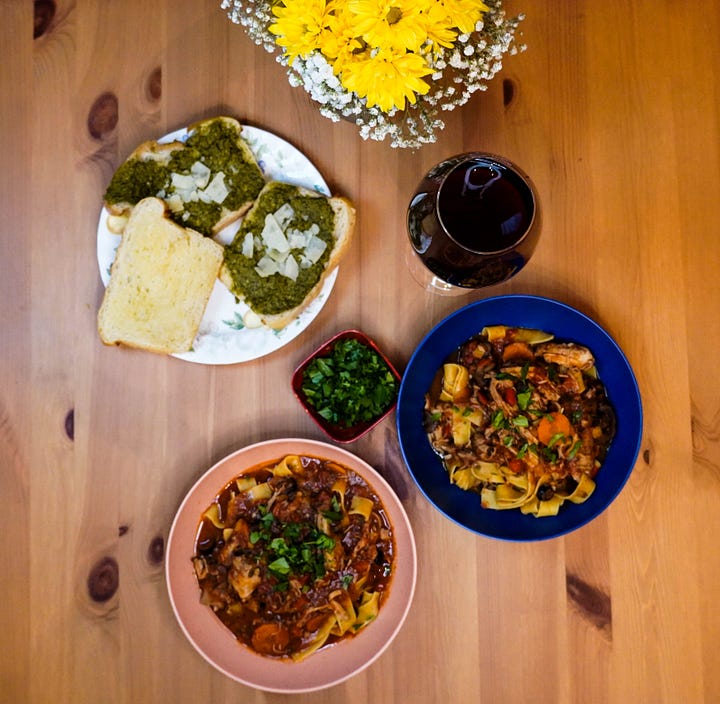
This Week's Recipes
What I am about to propose to you is possibly a sin in Italy. I am asking you to make a pasta dish with chicken.
I'm not entirely sure why chicken and pasta don't go together, other than the fact that chicken isn't historically very big in Italian cuisine, and that Italian cuisine generally serves pasta separately, before the meat. I think the "chicken in everything" mindset is probably thanks to us Americans, but it's also a big hit for the fitness crew.
So, back to Mr. Piastri and his pasta-tomato-sauce-chicken situation. I wanted to find a way to transform that kinda-bland kinda-boring concept into something delicious. I've opted to create chicken cacciatore pasta.
Roughly translated, cacciatore signifies a "hunter" style meal of chicken, rabbit, or other game stewed with onions, tomatoes, veggies, and wine. I've picked a chicken cacciatore recipe from Café Delites, to which I will be adding pasta. Because we're creating an Italian dinner version of Frankenstein's monster, you can use whatever pasta your heart desires.
Core Recipes:
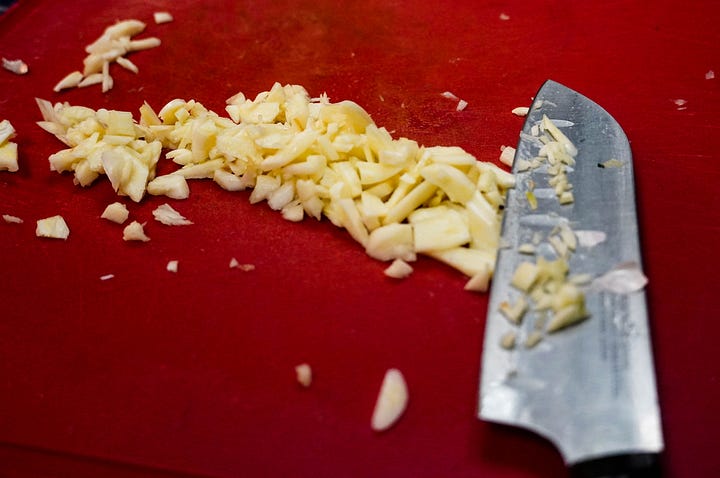
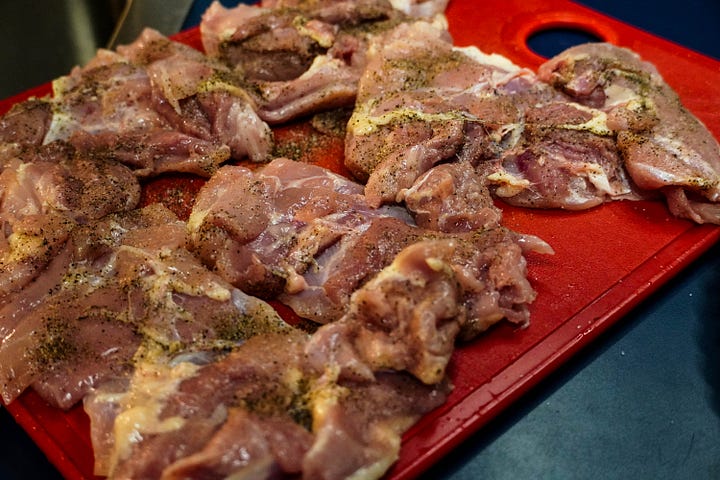
Cooking Chicken Cacciatore With Pasta
As with most stewed dishes, the toughest part of chicken cacciatore is the prep work and the flavor layering as you start cooking everything up. To explain what I mean, let's walk through the cooking process together.
First, prep. Dice your onion, yellow bell pepper, and red bell pepper. Mince your garlic. Peel and slice your carrot. Wash and slice your mushrooms. Halve (or dice) your Roma tomatoes. (In a more authentic version of this dish, you should be halving the tomatoes. However, my husband is not a big Tomato Guy, so I diced mine up nice and small so that they wouldn't be so chunky and offensive.) Chop your parsley and basil. Then, season your chicken thighs on both sides with salt and pepper. If you are like me, this will take you a hot second, because you are a slow moving vehicle. Don't worry about it.
In a nice big pot, you'll heat some olive oil and cook your chicken thighs on both sides until they're golden brown. Pull ‘em out and set them off to the side. Then sauté your onion until transparent, and toss in your garlic. When that's smelling delicious, add in all your veggies (except for the tomatoes) and herbs. You just want to soften everything before you pop in some wine and let that reduce.
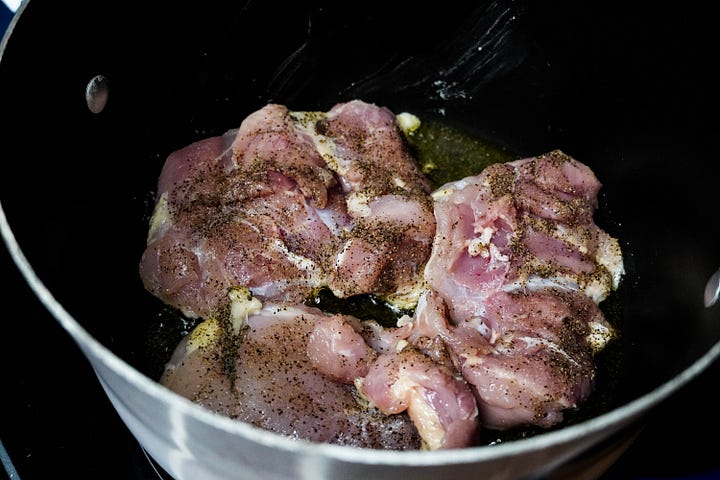

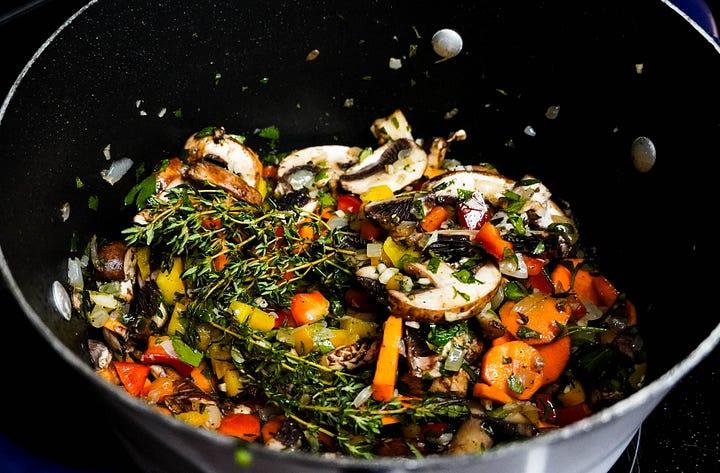
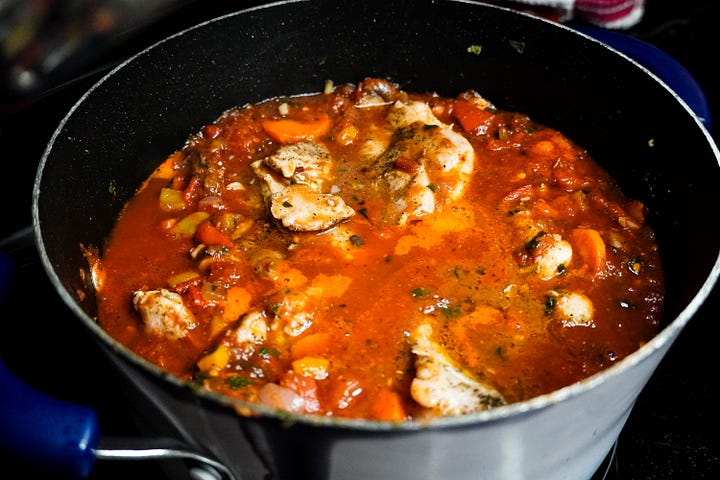
Then, add in your can of crushed tomatoes, your tomato paste, your Roma tomatoes, and your chili flakes. Have a taste and toss in some salt and pepper if you need it. Then, nestle your chicken back into the pot.
From there, it's mostly just a waiting game. Cover the pot and let the whole thing simmer for about 40 minutes. If you're using bone-in chicken, you'll know you're ready to roll when the chicken is falling off the bone. Otherwise, you can do what I did, and pull the chicken back out to shred it up a bit before throwing it back in. Ten minutes before you're ready to serve, add in the black olives and let it keep on simmering.
If you're going the “pasta dish” route, then boil up the pasta noodle of your choice. I went with pappardelle, because I love pappardelle, but you can do whatever your heart desires. Cook almost to package instructions; if you're using dried pasta, finish your last two-ish minutes of cooking in the chicken cacciatore itself. Then dish yourself up a nice big serving.
The Wine List
For Oscar Piastri's chicken cacciatore pasta, I've opted for a chianti classico as my wine pairing. Let's talk about what chianti classico actually… is.
If you're in the mood for chianti, you'll probably find three options on the shelves: chianti, chianti classico, and chianti riserva. Basically, that just means that each of these kinds of chianti differ in quality. All chianti is made primarily with sangiovese grapes, but plenty of winemakers toss in other grapes — including white grapes! — to cut costs. Standard chianti has to be made of 75% sangiovese grapes, but you can toss in those other white wine grapes to bulk up production.
Chianti classico is a step up in quality. If you want your wine to earn this designation, you have to use 80% sangiovese grapes in your bottle, but you have to use other red grapes if you're looking to supplement your haul. There are other rules here, but another big one that will impact flavor is that the wine has to spend 12 months aging in oak barrels to earn the “classico” designation.
Chianti riserva is basically chianti classico that has been aged for at least two years in oak barrels and then spent an additional three months aging in the bottle. You'll also see the “riserva” label on other kinds of Italian wines, since that indicates a process of aging as opposed to a a wine-making process.
Regular chianti has really bright, cherry-like flavors, but for chicken cacciatore, you want something a little more complex. It's a tomato-heavy dish, and a lot of folks find it challenging to pair wine with tomatoes — but it also helps to think of pairing wines to foods as a more comprehensive process. Hearty sewed dishes with lots of herbs and earthy veggies will work really well with something that has a little bit of age to it. Chianti classico is a great wine for chicken cacciatore because yes, it is delicious, but it's also not too fancy; you definitely want the age in your wine, but you also don't need to go overboard. I love a quality wine, but I'm also not going to break the bank for a weeknight dinner.
So, What's The Verdict?
Has there ever been a bad stew? Can a meal ever be bad if it includes pasta? To both of those questions, I think the answer is, simply, “no.” This chicken cacciatore pasta was a delight, both to cook and to eat, and it's definitely one of those dishes I'm stoked to make again!
As far as the actual bulk of the dish went, I would only change one thing: I would let everything stew far longer. I made the rookie mistake of beginning my dinner prep a little late in the day, so I was a bit more pressed for time than I would have liked for a dish that benefits from a long, lazy simmer. I prefer my stews a little thicker, and my tomatoes melted down a bit more. It wasn't the end of the world — just a “live and learn” type deal.
My big error here was my pesto bread. Dear god, my pesto bread. What in God's name was I thinking????
I'm just going to disclose up front that I have barely ever worked with pesto before. The extent of my pesto experience has been adding a spoonful to other pasta sauces for a little extra oomph. When my husband asked if I'd warm up some leftover homemade sandwich bread and top it with pesto, I thought I was doing the proper thing by stacking my topping high — the same way I would with a garlic-cheese topping. Friends: that was a mistake. Apparently you don't need to use half a jar of pesto on two slices of bread! Apparently you only need a smidge!
The pesto bread situation was frankly intolerable — but everything else was divine. Oscar Piastri, thank you for being very vague and letting me whip up a very fun interpretation of a dish I've always wanted to try.
Ready… Set… COOK!
If you’re interested in seeing the progression of Grand Prix Gastronomy, you’ll be able to do so in a few places. Instagram will feature most of the visual content, while Substack will be a little wordier. If you need a handy mid-week roundup, you’ll be able to find those on Twitter.
Here are all the relevant links in one place, if you want to subscribe:
All Grand Prix Gastronomy-related content will be free — but if you want to drop me a donation on PayPal, that’s always welcome.
Plus, if you're looking to delve deeper into motorsport history, don't forget to check out my new podcast, Deadly Passions, Terrible Joys! I have a Patreon; sign up, and you'll receive extra content!





